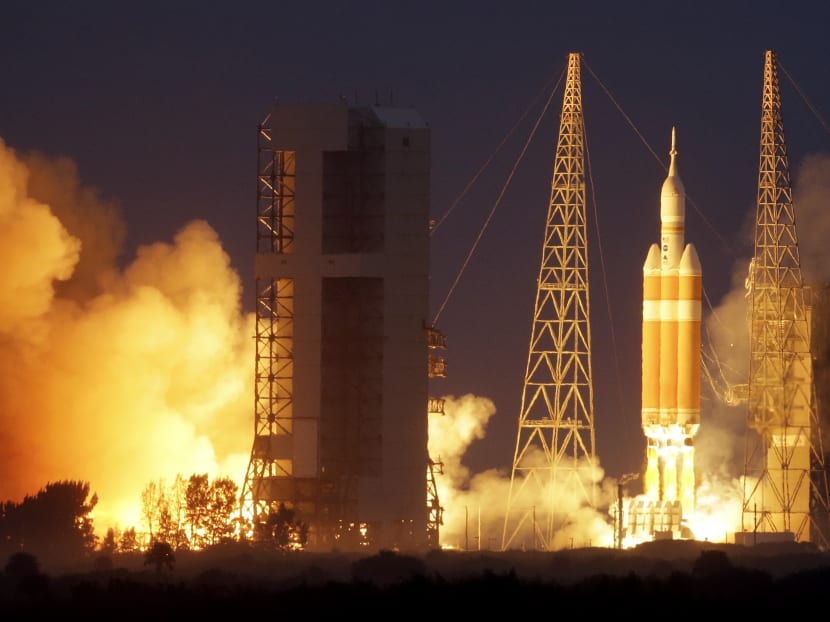NASA launches new Orion spacecraft and new era
CAPE CANAVERAL — The National Aeronautics and Space Administration’s (NASA) new Orion spacecraft streaked into orbit today (Dec 5) on a high-stakes test flight meant to usher in a new era of human exploration leading ultimately to Mars.

NASA's Orion spacecraft, atop a United Launch Alliance Delta 4-Heavy rocket, lifts off on its first unmanned orbital test flight from the Cape Canaveral Air Force Station Dec 5, 2014, in Cape Canaveral. Photo: AP
CAPE CANAVERAL — The National Aeronautics and Space Administration’s (NASA) new Orion spacecraft streaked into orbit today (Dec 5) on a high-stakes test flight meant to usher in a new era of human exploration leading ultimately to Mars.
The unmanned orbital journey began with a sunrise liftoff witnessed by thousands of NASA guests. Parts of the spacecraft peeled away exactly as planned, falling back toward Earth as onboard cameras provided stunning views of our blue, cloud-covered planet.
“The star of the day is Orion,” said NASA Administrator Charles Bolden Jr, back for the second morning in a row. He called it “Day One of the Mars era”.
Watch the Orion liftoff:
Video: NASAKennedy/YouTube
Orion’s debut will be brief — just four-and-a-half hours from launch to splashdown, with two orbits of Earth. But for the first time in 42 years, NASA is sending a spacecraft built for humans farther than a couple hundred miles from Earth. The previous time was the Apollo 17 moon shot.
And it’s NASA’s first new vehicle for space travel since the shuttle.
Today’s flight test brings NASA “one step closer” to putting humans aboard Orion, Mr Bolden said just before liftoff.
Sluggish rocket valves and wind halted yesterday’s launch attempt. Everything went NASA’s way today as the Delta IV rocket carried Orion over the Atlantic and up into orbit.
NASA was aiming for a peak altitude of 5,800km on Orion’s second lap around the planet, in order to give the capsule the necessary momentum for a scorchingly high-speed re-entry over the Pacific. Engineers want to see how the heat shield — the largest of its kind ever built — holds up when Orion comes back through the atmosphere travelling 32,000kmh and enduring 2,200°C.
The atmosphere at Kennedy Space Centre was reminiscent of the shuttle-flying days. After more than three years since the last shuttle flight, NASA revelled in all the attention.
Roads appeared to be less jammed before dawn for try two, and NASA was uncertain how many of the estimated 27,000 invited guests returned. Nonetheless, the press site remained jammed, the hotels packed and the excitement level high. “It’s a big day for the world, for people who know and like space,” Mr Bolden said, observing the crowds.
In Houston, NASA’s Mission Control took over the entire operation once Orion was aloft. The flight program was loaded into Orion’s computers well in advance, allowing the spacecraft to fly essentially on autopilot. Flight controllers — all shuttle veterans — could intervene in the event of an emergency breakdown.
And in the Pacific off the Mexican Baja coast, Navy ships waited for Orion’s return.
The spacecraft is rigged with 1,200 sensors to gauge everything from heat to vibration to radiation. At 3.35m tall with a 5m base, Orion is bigger than the old-time Apollo capsules and more advanced.
NASA deliberately kept astronauts off this first Orion.
Managers want to test the riskiest parts of the spacecraft — the heat shield, parachutes, various jettisoning components — before committing to a crew. In addition, on-board computers were going to endure the high-radiation Van Allen belts; engineers wondered whether they might falter.
Lockheed Martin Corp already has begun work on a second Orion, and plans to eventually build a fleet of the capsules. The earliest that astronauts might fly on an Orion is 2021. An asteroid redirected to lunar orbit is intended for the first stop in the 2020s, followed by Mars in the 2030s.
The company handled the US$370 million (S$488 million) test flight for NASA from the Cape Canaveral Air Force Station, opting for the Delta IV rocket this time given its heft. It’s the most powerful unmanned rocket in the US right now. The entire rocket and capsule, topped by a launch abort tower, stretched 73.76m and weighed 73,000kg — an “incredible monster”, according to Mr Bolden.
To push Orion farther out on future flights, NASA is developing a mega-rocket known as Space Launch System or SLS. The first Orion-SLS combo will fly around 2018, again without a crew to shake out the rocket.
NASA’s last trip beyond low-Earth orbit in a vessel built for people was the three-man Apollo 17 in December 1972. Orion will be capable of carrying four astronauts on long hauls and as many as six on three-week hikes.
Dozens of astronauts, present and past, gathered at Kennedy for the historic send-off. One of them — Mr Bolden — now leads NASA.
He called Mars “the ultimate destination of this generation”, but said his three young granddaughters think otherwise, telling him, “Don’t get hung up on Mars because there are other places to go once we get there.” AP






